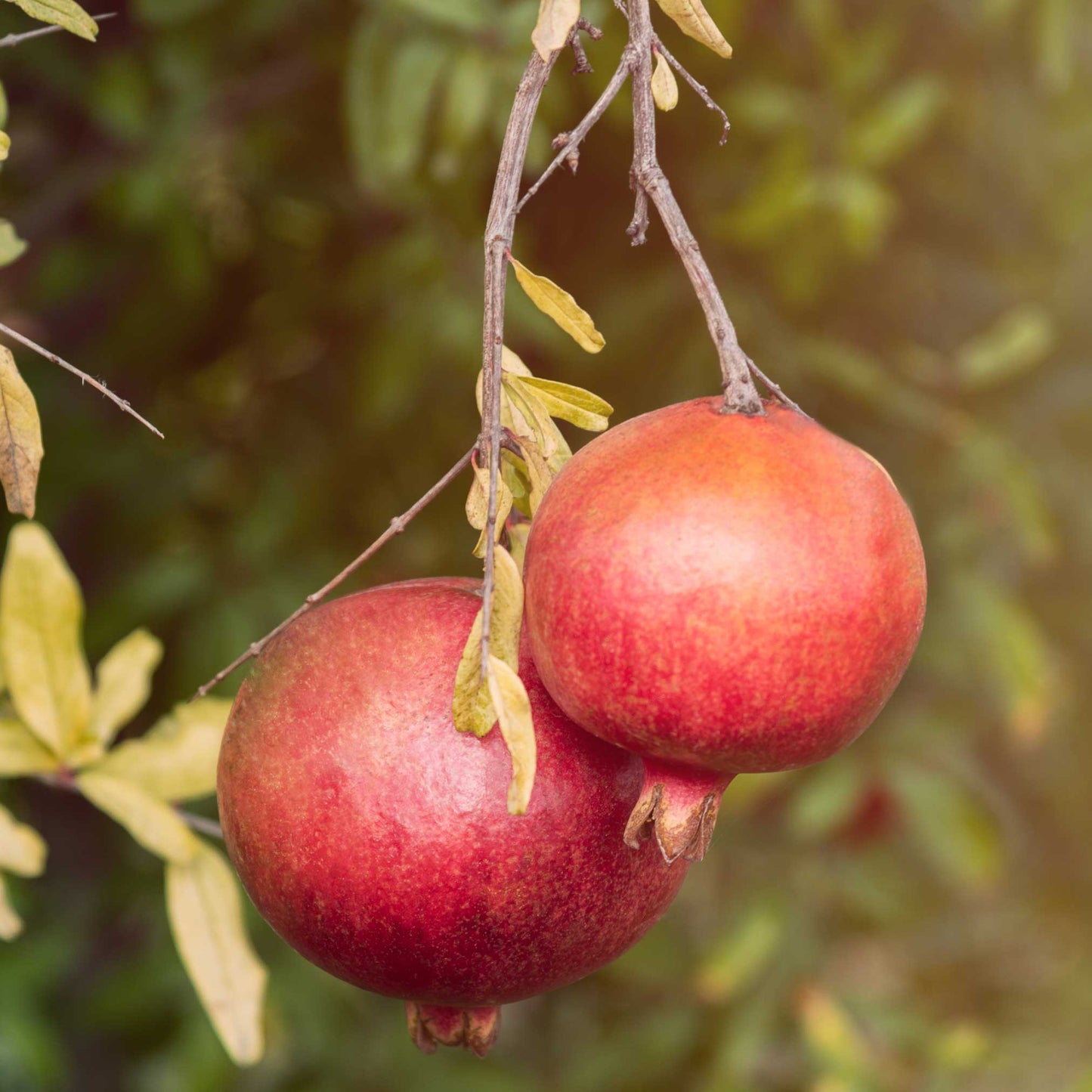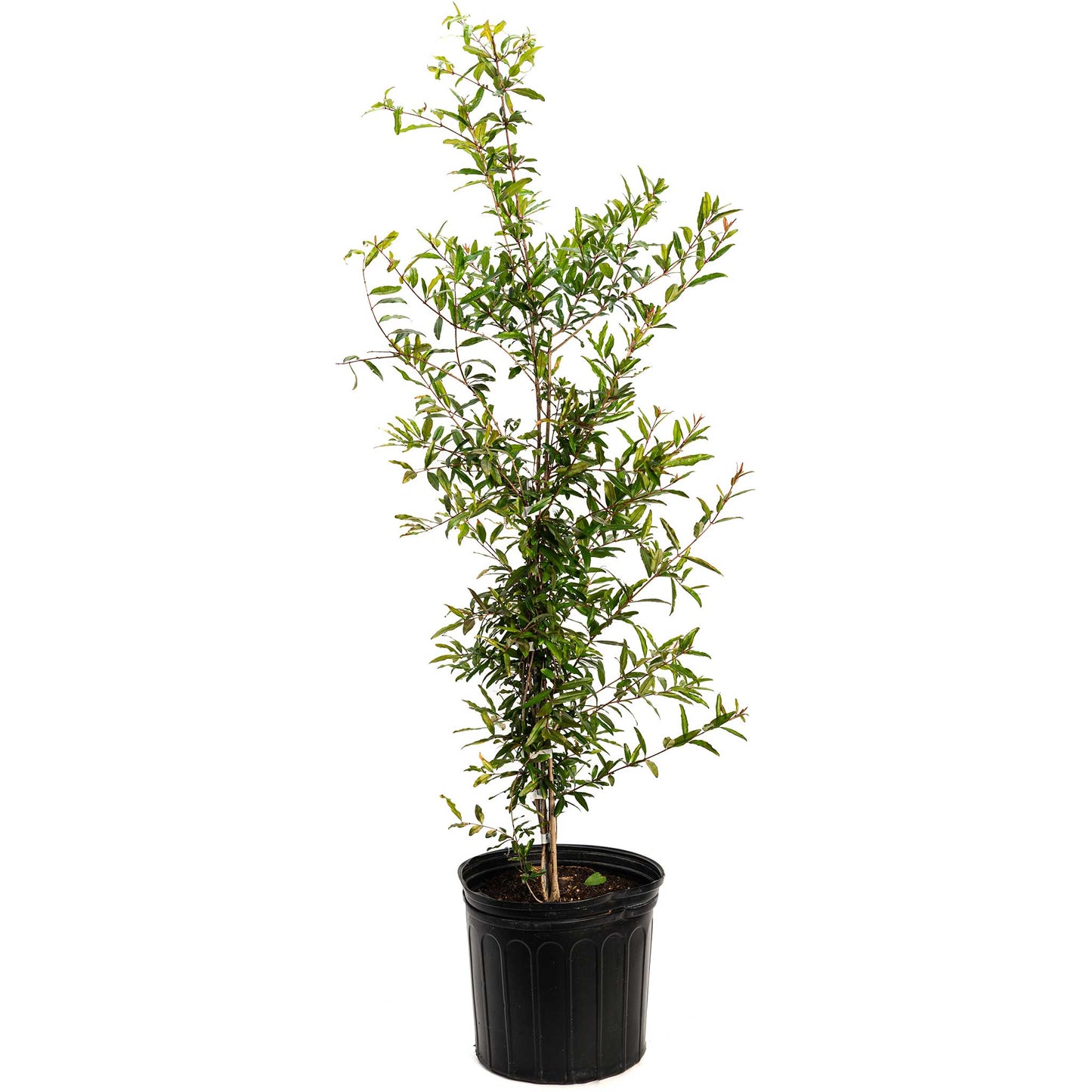Cold Hardy Red Pomegranate
Cold Hardy Red Pomegranate
SKU:EDB-POM-COL-45-3G
Meet Your New Hardy Garden Hero
Imagine a lush, vibrant garden that not only wows your neighbors but also rewards you with delicious, juicy fruits. The Cold Hardy Red Pomegranate does just that! This resilient plant is not just a pretty face; it's a powerhouse of versatility.
Why You'll Love Your Cold Hardy Red Pomegranate:
- Winter Warrior: It laughs in the face of cold, thriving in chillier climates where others fear to bloom.
- Summer Sizzle: As the mercury rises, your pomegranate's sun-loving nature kicks in, offering a fiery display of red flowers that later turn into iconic, ruby-red fruits.
- Low Maintenance: Forget about fussy plants. This pomegranate is as easy-going as they come, asking for little but giving so much.
- Eco-Friendly: Attracting pollinators like bees and butterflies, it's a nature lover's dream, making your garden a buzzing habitat.
Practical Perks:
Not only does the Cold Hardy Red Pomegranate bring a pop of color to your outdoor space, but it also serves up home-grown nutrition. Each fruit is packed with antioxidants, perfect for a healthy snack or a colorful addition to your culinary creations.






Product Details
-
Product Category
Edibles
-
Product Subcategory:
Pomegranates
-
Botanical Name:
Punica granatum 'Salavatski'
-
Does Not Ship To:
AZ, OR
-
Mature Height:
8-10 ft.
-
Mature Width:
8-10 ft.
-
Growing Zone:
6-9 outdoors
-
Indoor Growing:
-
Sunlight:
Full Sun
-
Growth Rate:
Fast
-
Harvest Time:
September
-
Bloom Time:
Spring

Planting Directions
<h2>Planting Cold Hardy Red Pomegranate</h2>
<p>Choose a sunny location with well-draining soil. Space the plants about 15 feet apart to accommodate their mature size.</p>
<ul>
<li>Dig a hole twice the width and the same depth as the root ball.</li>
<li>Mix some compost or aged manure into the excavated soil.</li>
<li>Place the plant in the hole, ensuring it's at the same depth it was in the pot.</li>
<li>Backfill the hole with the amended soil, tamping down gently to remove air pockets.</li>
<li>Water thoroughly to settle the soil around the roots.</li>
<li>Mulch around the base to retain moisture and suppress weeds, avoiding the stem.</li>
</ul>
<h2>Care and Maintenance</h2>
<p>Water regularly during the first growing season to establish a deep root system. Once established, water deeply but less frequently.</p>
<ul>
<li>Fertilize in spring with a balanced fertilizer designed for fruiting plants.</li>
<li>Prune in late winter to remove dead or crossing branches and to shape the tree.</li>
<li>Monitor for pests and diseases and treat as necessary.</li>
</ul>
<h2>Pollination</h2>
<p>Pomegranates are self-fertile, but cross-pollination by insects can increase fruit set. Planting more than one pomegranate or encouraging pollinators can be beneficial.</p>
<h2>Harvesting</h2>
<p>Fruit is typically ready to harvest in the fall when the skin is a deep red and makes a metallic sound when tapped. Cut the fruit from the tree rather than pulling.</p>
<p>Remember, patience is key with pomegranates; they can take a few years to start producing fruit. Enjoy the process and the eventual bounty!</p>

FAQs
<h2>FAQs for the Cold Hardy Red Pomegranate</h2>
<ol>
<li>
<strong>How do I plant a Cold Hardy Red Pomegranate tree?</strong>
<p>Follow these steps for planting:</p>
<ul>
<li>Choose a sunny spot with well-draining soil.</li>
<li>Dig a hole twice as wide and just as deep as the root ball.</li>
<li>Mix in compost with the removed soil.</li>
<li>Place the tree in the hole, ensuring it's level with the surrounding ground.</li>
<li>Backfill the hole, gently tamping down the soil to remove air pockets.</li>
<li>Water thoroughly to settle the soil around the roots.</li>
<li>Mulch around the base to retain moisture and regulate soil temperature.</li>
</ul>
</li>
<li>
<strong>What is the best fertilization schedule for a Cold Hardy Red Pomegranate?</strong>
<p>To ensure healthy growth and fruit production, follow this fertilization guide:</p>
<ul>
<li>Apply a balanced, slow-release fertilizer in early spring as new growth appears.</li>
<li>Repeat fertilization in late spring or early summer to support fruit development.</li>
<li>Avoid fertilizing late in the season to prevent new growth from being damaged by frost.</li>
</ul>
</li>
<li>
<strong>How do I ensure proper pollination of my pomegranate tree?</strong>
<p>Pomegranates are self-fertile, but you can enhance fruit set by:</p>
<ul>
<li>Planting more than one tree to increase cross-pollination.</li>
<li>Attracting pollinators like bees to your garden by planting pollinator-friendly flowers nearby.</li>
<li>Gently shaking the branches during flowering to help spread pollen.</li>
</ul>
</li>
<li>
<strong>When and how should I harvest pomegranate fruits?</strong>
<p>Harvesting tips include:</p>
<ul>
<li>Wait until fruits are fully colored and make a metallic sound when tapped, typically in fall.</li>
<li>Use pruning shears to cut the fruit stem, leaving a short piece of the stem attached.</li>
<li>Handle fruits carefully to avoid bruising.</li>
</ul>
</li>
<li>
<strong>How do I protect my pomegranate tree during winter?</strong>
<p>Although Cold Hardy Red Pomegranates are resilient, take these steps in colder areas:</p>
<ul>
<li>Apply a thick layer of mulch around the base to protect the roots from freezing.</li>
<li>Wrap the trunk with burlap or tree wrap in regions with severe winters.</li>
<li>Consider using a frost cloth to cover the entire tree on particularly cold nights.</li>
</ul>
</li>
</ol>







